
Cargado el 5 de noviembre, 2009
Galería de Hans Ollermann
King Ramses II (also called Ramses the Great) 1279-1212 B.C.
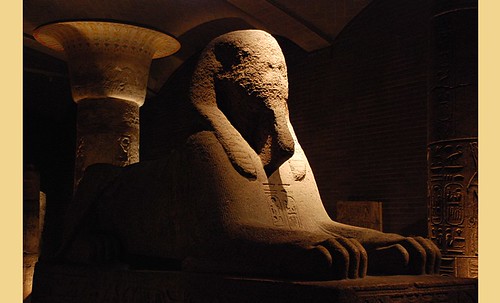
2007_0727_170451AA
The third largest known Sphinx in the world in a majestic and almost magical setting of the University of Pennsylvania Museum.
The Sphinx once stood in the Palace of King Merenptah at Memphis, Egypt.
Dynasty 19, Reigns of Ramesses II and
Merenptah (1279-1204 B.C.)
The Sphinx, a lion with a human head, represents the power of the Egyptian king. both to protect his people and to conquer the enemies of Egypt.
This Sphinx was burried up to its shoulders; only the exposed head was attacked by windblown sand, which eroded the facial features and the royal false beard. The inscriptions on the chest and around the base give the five names of Ramesses II. His son and successor Merenptah added his own cartouches to the shoulders after his father's death. This most impressive sphinx weighs about twelve tons. It was quarried at Aswan and transported by river to the Ptah Temple at Memphis, 600 miles away.
University of Pennsylvania Museum, Philadelphia.
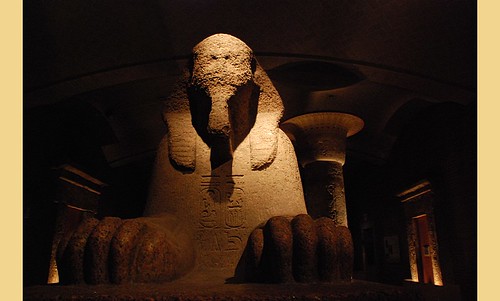
2007_0727_170150AA
The third largest known Sphinx in the world in a majestic and almost magical setting of the University of Pennsylvania Museum.
The Sphinx once stood in the Palace of King Merenptah at Memphis, Egypt.
Dynasty 19, Reigns of Ramesses II and
Merenptah (1279-1204 B.C.)
The Sphinx, a lion with a human head, represents the power of the Egyptian king. both to protect his people and to conquer the enemies of Egypt.
This Sphinx was burried up to its shoulders; only the exposed head was attacked by windblown sand, which eroded the facial features and the royal false beard. The inscriptions on the chest and around the base give the five names of Ramesses II. His son and successor Merenptah added his own cartouches to the shoulders after his father's death. This most impressive sphinx weighs about twelve tons. It was quarried at Aswan and transported by river to the Ptah Temple at Memphis, 600 miles away.
University of Pennsylvania Museum, Philadelphia.
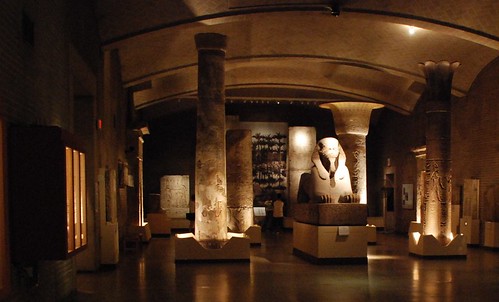
2007_0727_170339AA
The third largest known Sphinx in the world in a majestic and almost magical setting of the University of Pennsylvania Museum.
The Sphinx once stood in the Palace of King Merenptah at Memphis, Egypt.
Dynasty 19, Reigns of Ramesses II and
Merenptah (1279-1204 B.C.)
The Sphinx, a lion with a human head, represents the power of the Egyptian king. both to protect his people and to conquer the enemies of Egypt.
This Sphinx was burried up to its shoulders; only the exposed head was attacked by windblown sand, which eroded the facial features and the royal false beard. The inscriptions on the chest and around the base give the five names of Ramesses II. His son and successor Merenptah added his own cartouches to the shoulders after his father's death. This most impressive sphinx weighs about twelve tons. It was quarried at Aswan and transported by river to the Ptah Temple at Memphis, 600 miles away.
University of Pennsylvania Museum, Philadelphia.
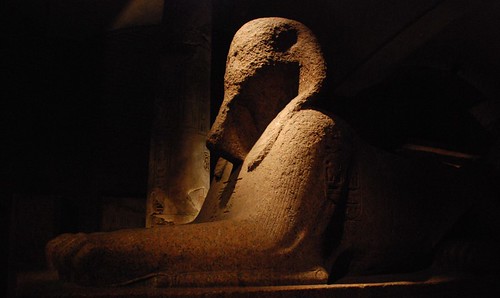
2007_0727_170139AA
The third largest known Sphinx in the world in a majestic and almost magical setting of the University of Pennsylvania Museum.
The Sphinx once stood in the Palace of King Merenptah at Memphis, Egypt.
Dynasty 19, Reigns of Ramesses II and
Merenptah (1279-1204 B.C.)
The Sphinx, a lion with a human head, represents the power of the Egyptian king. both to protect his people and to conquer the enemies of Egypt.
This Sphinx was burried up to its shoulders; only the exposed head was attacked by windblown sand, which eroded the facial features and the royal false beard. The inscriptions on the chest and around the base give the five names of Ramesses II. His son and successor Merenptah added his own cartouches to the shoulders after his father's death. This most impressive sphinx weighs about twelve tons. It was quarried at Aswan and transported by river to the Ptah Temple at Memphis, 600 miles away.
University of Pennsylvania Museum, Philadelphia.
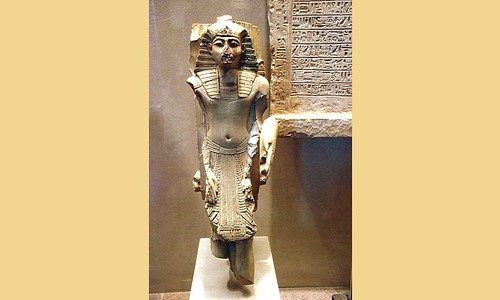
2007_0724_163217AA
Fragment of a votive statue.
Dynasty 19, reign of Ramesses II.
(ca.1304-1237 B.C.).
Egyptian artefacts in The Metropolitan Museum of Art, New York.
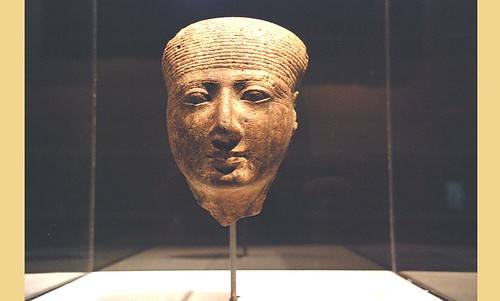
2007_0724_162750AA
Head of a goddess.
Early dynasty 19, reign of Seti I or early years of Ramesses II.
Egyptian artefacts in The Metropolitan Museum of Art, New York.
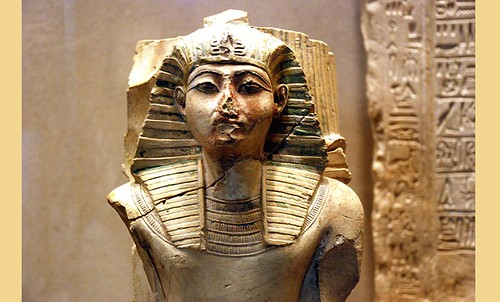
2007_0724_163223AA
Fragment of a votive statue.
Dynasty 19, reign of Ramesses II.
(ca.1304-1237 B.C.).
Egyptian artefacts in The Metropolitan Museum of Art, New York.
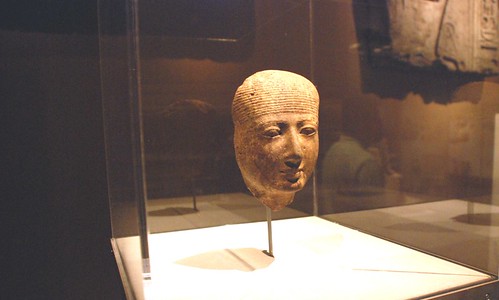
2007_0724_162743AA
Head of a goddess.
Early dynasty 19, reign of Seti I or early years of Ramesses II.
Egyptian artefacts in The Metropolitan Museum of Art, New York.
Intef II
De Wikipedia, la enciclopedia libre
Uahanj Intef, o Intef II, c. 2103-2054 a. C. (von Beckerath) fue un rey de la dinastía XI, durante el primer periodo intermedio de Egipto.
Contenido |
Biografía [editar]
Fue gobernante de Uaset (Tebas) y el sucesor de su hermano, Intef I.
En esta época Egipto estaba fragmentado entre varias dinastías locales. Después de la muerte del nomarca Anjtifi, Intef II fue capaz de reunir bajo su mando todos los nomos meridionales desde Uaset (Tebas) hasta hasta la primera catarata del Nilo.
Inicialmente las relaciones con el Jety III, de Heracleópolis Magna, fueron bastante cordiales pero Intef atacó y conquistó el nomo de Afroditópolis aunque pronto sería recuperado por el nuevo nomarca de Heracleópolis, Merykara. También tomó la ciudad principal del nomo tinita, Abidos. La ciudad cambió de manos varias veces, pero Intef finalmente quedaría victorioso, extendiendo su reino hasta el nomo XIII.
Después de estas guerras, se establecieron relaciones más amistosas y el resto de su reinado sería pacífico. La situación en la frontera se tornaría incierta durante un tiempo pero Intef II puso las bases de la ofensiva definitiva que acometerá Mentuhotep I.
Testimonios de su época [editar]
En la sala de antecesores de Karnak Intef II es mencionado como sucesor de Intef I y predecesor de Intef III. En el templo de Montu en Tod existe un relieve en el que se representa a Mentuhotep I con Intef II e Intef III ofrendando al dios Montu. Los primeros testimonios del dios Amón en Karnak fueron fechados durante su reinado.
A Intef II se le enterró en una tumba, horadada en la roca, en Saff el-Kisasiya, en la ribera occidental de Tebas, próxima a la de su hermano y predecesor, Intef I. En la capilla de la tumba, se encontró una estela con un relieve del faraón y sus perros. La estela es muy famosa porque muestra a sus perros favoritos y sus nombres, no egipcios, con las traducciones egipcias. Seguramente es la representación más antigua de unos perros con sus nombres. Estos son Behekay "gacela", Abaqer "galgo" y Pehetes "negro" (Museo Egipcio de El Cairo).
Reconstruyó el templo de Satet en Elefantina. Una Estela en Tebas, menciona a Uahanj Intef.[1]
Titulatura [editar]
| Titulatura | Jeroglífico | Transliteración (transcripción) - traducción - (procedencia) |
| Nombre de Horus: |
| u3h ˁnḫ (Uahanj) El que refuerza la vida (J.J. Clére, J. Vandier, 1948, X, 16-20) |
| Nombre de Sa-Ra: |
| s3 rˁ in(i) t.f (Sa Ra Intef) Hijo de Ra, Intef (J.J. Clére, J. Vandier, 1948, X, 20-24) |
| Nombre de Sa-Ra: |
| s3 rˁ in(i) t.f ˁ3 (Sa Ra Intef aa) Hijo de Ra, Intef, el Grande (Estela funeraria de Intef II, en Tebas) |
Referencias [editar]
- Referencias digitales
- http://www.digitalegypt.ucl.ac.uk//chronology/antefii.html (en inglés)
- http://www.narmer.pl/dyn/11en.htm (en inglés)
Enlaces externos [editar]
 Wikimedia Commons alberga contenido multimedia sobre Intef II. Commons
Wikimedia Commons alberga contenido multimedia sobre Intef II. Commons
| Predecesor: Intef I | Faraón Dinastía XI | Sucesor: Intef III |
Intef II
From Wikipedia, the free encyclopedia
| Intef II | ||||
|---|---|---|---|---|
| Inyotef II, Antef II | ||||
 | ||||
| Funerary stele of Intef II, on display at the Metropolitan Museum of Art. | ||||
| Pharaoh of Egypt | ||||
| Reign | 2118–2069 BC, 11th dynasty | |||
| Predecessor | Intef I | |||
| Successor | Intef III | |||
| Children | Intef III, Iah | |||
| Father | Mentuhotep I | |||
| Mother | Neferu | |||
| Died | 2069 BC | |||
Intef II was a Pharaoh of the Eleventh dynasty during the First Intermediate Period. His capital was located at Thebes. At this time, Egypt was split between several local dynasties. After the death of the nomarch Ankhtifi, Intef II was able to unite all the southern nomes down to the First Cataract. After this he clashed with his main rivals, the nomarchs of Herakleopolis Magna for the possession of Abydos. The city changed hands several times, but Intef II was eventually victorious, extending his rule north to the thirteenth nome.
After these wars, more friendly relations were established and the rest of Intef's reign was peaceful. The discovery of a statue of Intef II, wrapped in a sed festival robe, in the sanctuary of Heqaib at Elephantine suggests that this king's authority extended to the region of the First Cataract and, perhaps, over part of Lower Nubia by his 30th year.[2] This impression would appear to be confirmed by an expedition led by Djemi from Gebelein to the land of Wawat (ie: Nubia) during his reign.[2] Consequently when Intef II died, he left behind a strong government in Thebes which controlled the whole of Upper Egypt and maintained a border just south of Asyut.[2]
The earliest attested dating of the god Amun at Karnak occurs during his reign. The surviving sections of the Turin Canon for the Middle Kingdom with Intef II; it assigns this king a reign of 49 years.[3]
[edit] References
- ^ a b Clayton, Peter A. Chronicle of the Pharaohs: The Reign-by-Reign Record of the Rulers and Dynasties of Ancient Egypt. Thames & Hudson. p72. 2006. ISBN 0-500-28628-0
- ^ a b c Nicholas Grimal, A History of Ancient Egypt (Oxford: Blackwell Books, 1992), p. 145
- ^ The Ancient Egypt Web Site, Antef II, (accessed September 7, 2007)
[edit] Further reading
- W. Grajetzki, The Middle Kingdom of Ancient Egypt: History,Archaeology and Society, Duckworth, London 2006 ISBN 0-7156-3435-6, 12-15
| Preceded by Intef I | Pharaoh of Egypt Eleventh Dynasty | Succeeded by Intef III |
| This article about Egyptology or subjects relating to Ancient Egypt is a stub. You can help Wikipedia by expanding it. |
Categories: Pharaohs of the Eleventh dynasty of Egypt | 2069 BC deaths | Ancient Egypt stubs
related articles
- Intef I
- Intef III
- Mentuhotep I
- Ankhtifi
- Intef
- Conventional Egyptian chronology
- Herakleopolis Magna
- Egyptian chronology
- Index of Egypt-related articles
- Nile Level Texts
En otros idiomas
- Català
- Česky
- Deutsch
- English
- Euskara
- Suomi
- Français
- Hrvatski
- Italiano
- 한국어
- Lietuvių
- Nederlands
- Polski
- Русский
- Srpskohrvatski / Српскохрватски
- 中文



















Hans Ollermann dice:
I agree.
May-be the Sphinx of Hatshepsut in Berlin is number 2.
Here is a photo of that Sphinx:
Hans